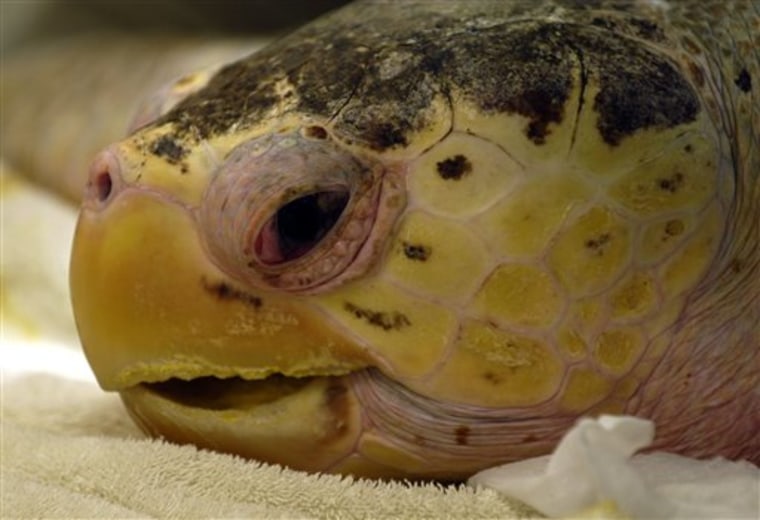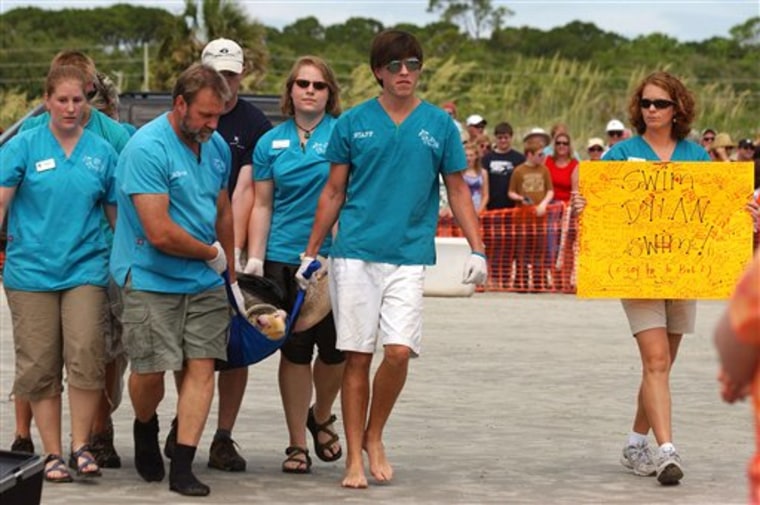A 150-pound sea turtle raised by humans returned to freedom on Monday after nine years of captivity, swimming away after the veterinarians who cared for her helped steer her toward the ocean.
Humans have raised the turtle, named Dylan, since she was found in August 1998 as a hatchling straggler on Jekyll Island's beach, left behind by her nest mates. She spent years at two nature centers before moving to the Georgia Aquarium, and later, the Georgia Sea Turtle Center at Jekyll Island.
The caretakers took the turtle to within 10 feet of water, and she scooted right in as about 300 people watched from the beach. She took an immediate right turn, swimming parallel to the beach. Terry Norton, head veterinarian at the Sea Turtle Center, helped wrestle the 150-pound turtle to turn her back out to sea.
He followed her out about 100 yards, going waist-deep into the water and then raised his arm, pointing out to sea to signal that the turtle was gone.
Norton said the turtle was trying to swim out to sea but apparently became confused by the shallow water and soft mud and began swimming parallel to the beach.
Dylan's release has been in the works for more than a year. The loggerhead sea turtle left her home at the Georgia Aquarium in May 2007 to live at the Georgia Sea Turtle Center on Jekyll Island, where the staff could prepare her to live on her own.
Might not return for 20 years
The turtle's caretakers drove Dylan to the beach Monday. Since she headed into the ocean as planned, she won't be expected to return to land until she starts laying eggs about 20 years from now.
"She's as ready as she's going to be," Norton said Sunday after returning Dylan to her tank after an hour-long last physical exam. "She's definitely strong."
Unlike most turtles rehabilitated at the Jekyll Island center, Dylan didn't have to recover from illness or injury. The biggest hurdle was teaching her to feed herself.
She was used to a mixture of ground fish, shrimp and squid frozen into blocks of ice. The first time a live blue crab was dropped into her tank at the Sea Turtle Center, she recoiled and swam to the other side of her tank.
Norton said the staff began feeding Dylan whole crabs that had been frozen to get her used to breaking their shells. Over time, she learned to kill and eat live crabs.

"Now, she's a voracious eater," Norton said. "She knows they're not going to hurt her."
Loggerhead sea turtles like Dylan are classified as a threatened species. Seven other varieties of sea turtles are endangered.
During her stay at the Sea Turtle Center, the staff learned Dylan is a female. It's nearly impossible to tell a sea turtle's gender until it reaches adulthood, which can take 30 years.
Tracked by satellites
Mark Dodd, a wildlife biologist with the Georgia Department of Natural Resources, said satellites can pick up a signal from a transmitter Dylan is wearing and can plot her location within about 100 yards. It's set up to start transmitting whenever she surfaces.
Dodd said he's interested to find out whether Dylan acts her age. Baby sea turtles tend to swim far out to sea where there are fewer predators. As adults, loggerheads return closer to the coastline in the shallower waters between Florida and North Carolina.
"The best thing for her would be to hang out here, get fat eating crabs and maybe 20 years from now we'll see her again laying eggs," Dodd said.
